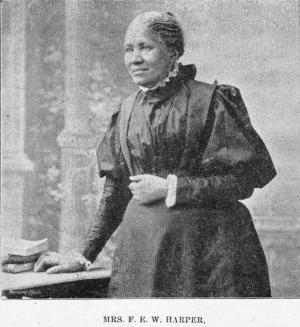Frances Ellen Watkins Harper

This is a short thirty-minute lesson on Frances Ellen Watkins Harper. In this lesson, students will react as a class to a quote from FEWH and then move into a sentence, phrase, word protocol.
Guiding Question: How did Frances Ellen Watkins Harper use her literary and oratorical talent to advance equality prior to and after the Civil War?
Supporting Question:
- What was life like for Black Americans in the post-Civil War United States?
- How did the lived experience of Frances Ellen Watkins Harper showcase the unique challenges black women faced in America in the aftermath of the Civil War?
- How can poetry all us to better under history?
30 minutes
- Students will be able to identify the strategies FEWH used to advocate for equality.
- Students will be able to contextualize the life and experiences for black women in America prior to the Civil War.
- Students will be able to contextualize poetry to historical periods and social movements.
For homework, students should read the one-page biography on FEWH on the National Women’s History Museum Website.
Four linked Primary and Secondary Sources
-
Learning to Read (Poem), Download (here)
-
We are All Bound Up Together (Excerpt), Download (here)
-
An Appeal to The American People (Poem), Download (here)
-
Bury Me in a Free Land (Poem), Download (here)
Chart Paper
Markers
Warm Up (5 minutes)
Ask students to react to the following quote:
“We are all bound up together in one great bundle of humanity, and society cannot trample on the weakest and feeblest of its members without receiving the curse in its own soul.” — FRANCES E.W. HARPER
How does this quote make you, see, wonder, think, or feel?
Activity (20 minutes):
Students should be broken up into groups of four to six and given an assigned text. Students will read a text as a group, pausing for clarifying questions.
After reading, students will identify a:
- Sentence that was meaningful and captures the core idea of the text
- Phrase that moved, engaged, or provoked
- Word that captured attention or struck as powerful
As a group students discuss and record their choices. Begin by sharing words, then phrases, then sentences in each round. Students will explain their selections: Looking at your group’s collective choices of words, phrases, and sentences, students will reflect on the conversation by identifying:
-
What themes emerge?
-
What implications or predictions can be drawn?
-
Were there aspects of the text not captured in your choices?
-
How did this work of FEWH advance equality?
At the conclusion, student will have a chart paper that shows the sentence, phrase, and word of each student and a student reflection on all four major questions.
Students from each group will be asked to identify one idea that emerged from their discussion about the life and times of FEWH
Discussion will conclude with the following questions:
“Why is this still relevant today? What can we take away and use in our work to create a more just society today?”
OR
“Sadly, FEWH is not taught in most US History classes today? Why do you think this is? AND What should be taught about her?”
- A range of level of writing has been provided and students can be provided the appropriate scaffold.
- The protocol allows for students to read the text aloud, pausing for clarifying questions
- Reenactment of FEWH, We are all Bound Up Together (New York Historical Society)
- Strategies for ELL Students When Reading Poetry
D2.His.3.9-12. Use questions generated about individuals and groups to assess how the significance of their actions changes over time and is shaped by the historical context
D2.His.14.9-12. Analyze multiple and complex causes and effects of events in the past.
